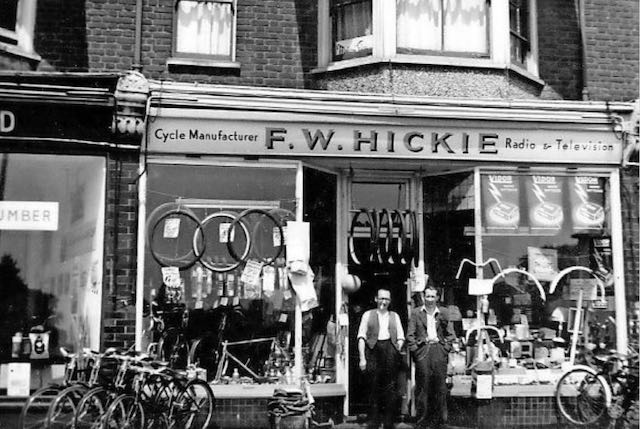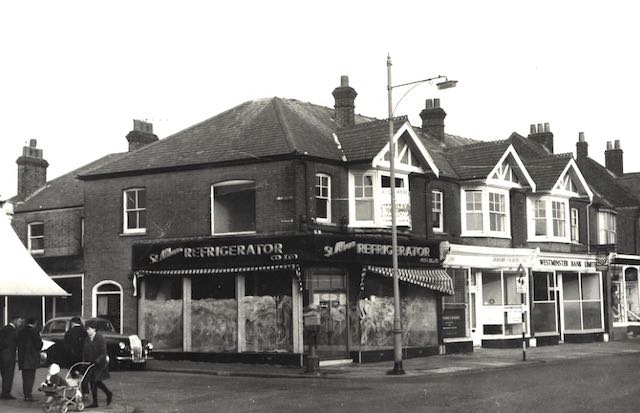Continuing our detailed virtual walk along Hatfield Road, and in some cases imagine we are early residents exploring the "mile of shops", last time we had reached Sandfield Road. The next block now takes us as far as Harlesden Road, although there is sufficient material this time to proceed roughly halfway – twelve properties would be too many for a single post! However, the perfect photo to begin with is Andy Lawrence's newly acquired picture of what the photographer had termed "The Promenade".
Since we left Glenferrie Road we would have been, in an earlier time, at the hedge line looking into a field formerly known as Long Moody, and already, by 1902, the corner plots now have buildings on them. At Sandfield Road this was a fine shop owned by Samuel J Gibbs who aspired to furnish the tenants and owners of the homes then being built around him. As a corner shop he was able to display two full windows, and as intended the Gibbs family lived above the shop. But as he became more successful the shop began to expand upstairs. Around 1910, Mr Gibbs therefore purchased number 4 Sandfield Road behind the shop – not far to travel to work! It was, in fact the only house, close to the Hatfield Road boundaries; otherwise land remained open until number 20, so what happened to number 2? Well, on the 1922 map a house seems to have been constructed on the rear garden of number 4. Perhaps an initiative of Mr Gibbs who felt he did not need a rear garden. So, even in those early days of the district extra houses were already being squeezed in!
Mr Gibbs handed the business on to Henry Lewis, and by the mid thirties Mr Graham Henderson opened a "curios and oddments shop" here, before moving it along to the Laurel Road corner after the war. The biggest change came with the re-forming of the Grimaldi business in the early days of peace, and its petrol and car maintenance business was augmented by a Rootes car sales showroom at number 149. Yes, two band new cars could be displayed inside the shop. Fleetville went into car sales! For a while you could purchase refrigerators and freezers from here, before Barclays upgraded the premises and moved its bank from the Crown, which it clearly felt was advantageous for business.
 |
| The arrival of Barclays Banks has also created modernised and smart external frontage. For the first time the building is without its first floor bay window. COURTESY BARCLAYS ARCHIVE |
The next pair of shops came four years later, but were undoubtedly built by the same company as the corner shop. Today, however the cohesive design is lost as the first floor bay window was removed in the later conversion to bank premises. Although number 151 spent some decades in George Weatherhead's care as a china shop, and then Charles Chuter for outfitting, undoubtedly the most well-known owner began here during the Second War: Frederick W Hickie. When petrol is in short supply people turn to their bikes; then radio continued its popularity and we became curious about the new television service, Mr Hickie and his son were happy to serve. Since the mid-sixties insurance and legal services have ventured into the suburbs to demystify one of life's needs which had formerly been found in the side roads of the city centre, sometimes above shops.
 |
| Hickie's bicycle and radio/tv shop in the 1950s, with father and son at the doorway. COURTESY THE HICKIE COLLECTION |
 |
| The complete development as it looked in 2012. Again, the first floor bay window and projecting eaves are now absent. |
Number 153 was one of the first shops to break away from from the notion of each trader having his or her own single shop. Charles Chuter ran his outfitter's from two adjacent properties from the 1920s, thereby signalling that retailing often needs a variety of footprints to work in. Soon after the war Westminster (later NatWest) moved to join other chains in serving Fleetville, and in recognition of its success, later moved to larger premises which we met last time on the west corner of Sandfield Road.
The next pair of shops was clearly intended for a specific purpose. James Andrews owned a building business. He had acquired land on the opposite side of Hatfield Road for his builders' yard. The righthand shop was in the care of his wife for the sale of builders and finishers accessories – and no doubt became the firm's office. To the left of the central vehicle arch a shop was available to let, which provided a regular rental income; a trade which, until the 1970s, served as one of Hatfield Road's regular and frequent grocery shops. Peep through the arch next time you are passing and the service buildings to the rear are still in regular use by the present occupiers of both shops: SK Carpets.
 |
| James Andrew's shop was on the right, but he owned both shops with access to workshops through the arch; the left shop was let to a succession of grocer's. |
Number 157's longest owner was was also one who had three successive trading addresses and saw Fleetville's very birth. Percy Stone's first store was where the Rats' Castle is today. He later moved to Bycullah Terrace, before moving again to 157. Although generally known as a newsagent's we would recognise its product range in any newsagent's we walk into today (except perhaps the lottery tickets). There are many former teenagers who will recall their daily roles as paper boys, propping their bikes against the wall under the arch before climbing the steps into the shop.
It is along this section of Hatfield Road where the feature of the ground floor front elevations follow the street line, while the first floors are turned to face due south. Although the two shops at 155 and 157 are modest in floor area, space being reserved for the arch, the first floor accommodation over the arch provides some compensation.




No comments:
Post a Comment